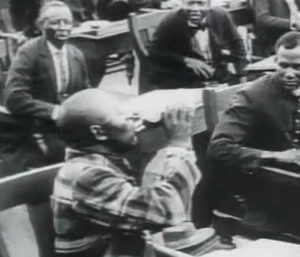Memory and Popular Culture
 In the early twentieth century a new medium - the motion picture, helped disseminate any number of Civil War and Reconstruction era recollections. One could argue (and many have) that the popularity of movies such as D.W. Griffith's The Birth of a Nation helped cement particular (often southern) memories of the war era and its aftermath into the national vernacular. Well, they certainly had a lasting impact when it came to how Americans remembered the conflict and what followed, but not everyone was on board. The NAACP, for example, was not so keen on the film and its depiction of slaves, freemen, and black soldiers. Union veterans in many cases also found this film to be a great misrepresentation of the cause.
Below is among the most controversial scenes. You will note that the film would suggest black representatives in the South Carolina Statehouse during Reconstruction did not necessarily wear shoes. Or, that they liked to drink whiskey and dance around waving chicken while in session. And it also seems that legalized interracial marriage could move black legislators to burst into a uproarious celebration.
In the early twentieth century a new medium - the motion picture, helped disseminate any number of Civil War and Reconstruction era recollections. One could argue (and many have) that the popularity of movies such as D.W. Griffith's The Birth of a Nation helped cement particular (often southern) memories of the war era and its aftermath into the national vernacular. Well, they certainly had a lasting impact when it came to how Americans remembered the conflict and what followed, but not everyone was on board. The NAACP, for example, was not so keen on the film and its depiction of slaves, freemen, and black soldiers. Union veterans in many cases also found this film to be a great misrepresentation of the cause.
Below is among the most controversial scenes. You will note that the film would suggest black representatives in the South Carolina Statehouse during Reconstruction did not necessarily wear shoes. Or, that they liked to drink whiskey and dance around waving chicken while in session. And it also seems that legalized interracial marriage could move black legislators to burst into a uproarious celebration.
http://youtu.be/R4v_yRFf4-Y
Like it or not, this is precisely how many Americans (especially white conservative southern Americans) "remembered" the period. So much so that memory and history seemed to blend seamlessly. A good number of people thought - just as Griffith had hoped - to be witnessing a true representation of history as it unfolded in the past. I can imagine why this caused such a fuss from opposing parties. I think it is difficult for people today to get their head around this film. I have showed it to students and they are not really quite sure what to say. If you have had similar experiences or have just now become acquainted with this film, I would love to hear your thoughts.
With compliments,
Keith